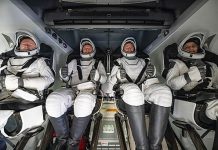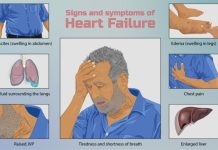One of unusual and most intriguing feature of heavily mutated Omicron variant is that it acquired all the mutations in a single burst in a very short span of time. The degree of change is so much so that some people think it could well be a new strain of human coronavirus (SARS-CoV-3 ?). How such a high level of mutation may have occurred in such a short span? Some argue that Omicron may have evolved from an immune suppressed patient with some chronic infection like HIV/AIDS. Or, could it have evolved in the current wave in Europe which has witnessed very high transmission rates? Or, could it be associated with some Gain-of function (GoF) research or anything else? Who benefits? It is not possible to draw any conclusion at this stage. Nevertheless, this article attempts to throw light on various dimensions associated with the phenomenon.
The recently reported new COVID-19 variant from South Africa on 25th November 2021 has spread to several countries in the world namely UK, Canada, Japan, Australia, Austria, Hongkong, Israel, Spain, Belgium, Denmark and Portugal. This has been designated as a new variant of concern (VOC) by the WHO and named Omicron. Omicron is characterised by 30 amino acid changes, three small deletions and one small insertion in the spike protein compared to the original virus1. However, based on the mutation rates2 of RNA viruses, it is not possible to develop 30 plus mutations overnight. It would take at least 3 to 5 months to generate 6 mutations in the 30kb genome of SARS-CoV-2 based on the mutation rate that the virus undergoes naturally2 upon transmission from host to host. Going by this calculation it should have taken 15 – 25 months for something like Omicron to emerge, bearing 30 mutations. However, the world has not seen this gradual mutation rise over the said period of time. It is argued that this variant evolved from a chronic infection of an immunocompromised patient, possibly an untreated HIV/AIDS patient. Based on the degree of change, it should well be classified as a new strain of virus (SARS-CoV-3 may be). Nevertheless, the number of mutations present might be indicative of its higher transmissibility than other variants. However, more studies are required to confirm this.
The next few weeks are critical to determine the transmissibility of the new variant and the severity of the disease it causes. Until now, all the cases have been mild and asymptomatic and the good news is that there has been no mortality. We also need to assess the extent to which the new variant can escape the immune protection provided by the current vaccines. This will allow us to decide on how long we can continue with the current vaccines before tailor making them for the new variant. Pfizer and Moderna have already taken steps towards tweaking their vaccines. However, the looming question still remains about the origin of this variant. It is plausible that the Omicron variant might have evolved in the current wave of higher incidence of cases in Europe much earlier, but was reported by the South African authorities recently (based on genome sequencing). However, this may not be the case as the current wave has been there for the past 4-5 months and according to mutation rates, should have resulted in not more than 5-6 mutations.
Or was Omicron, a product of Gain of Function (GoF) research leading to development of pandemic potential pathogens (PPPs)3,4. Gain of function research refers to experiments in which a pathogen (in this case SARS-CoV-2), gains the ability to perform a function that was otherwise not part of its regular existence. In this case, it could lead to increased transmissibility and increased virulence. This can potentially lead to the development of an organism that is novel and had not been in existence in nature. The intention of GoF research is to gain understanding of the pathogenic variants and be ready with a therapeutic or a vaccine, if such a variant arises in nature. The number of mutations gained by the PPPs, not only make the strain highly transmissible but also help to escape the neutralizing antibodies made against the original virus in convalescent individuals. In addition, strain manipulation is possible using modern genetic engineering techniques based on targeted RNA recombination5. This can also lead to novel pathogenic variants/strains with greater number of mutations, leading to a highly transmissible and virulent virus. Research has shown that 20 mutations occurring in the spike protein, including changes and deletions, are sufficient for evasion of the majority of the antibodies generated in the plasma of individuals that have been infected by or vaccinated against SARS-CoV-26. According to another study, under a strong immune pressure, SARS-CoV-2 can gain the capability of escaping the antibodies by making just 3 changes, two deletions in the N terminal domain and one mutation (E483K) in the spike proteinn7.
Should this kind of research be allowed that leads to generation of PPPs? In fact, the gain of function research was banned by the USA in 2014 by NIH, after a series of accidents involving mishandled pathogens at the US Centers for Disease Control and Prevention, suggesting that the risks associated with such kind of research, far outweigh the benefits it may provide. Who benefits from the emergence and spread of the such PPPs? These are tough questions that require real answers.
***
DOI: https://doi.org/10.29198/scieu/2112011
***
References:
- European Centre for Disease Prevention and Control. Implications of the emergence and spread of the SARSCoV-2 B.1.1. 529 variant of concern (Omicron), for the EU/EEA. 26 November 2021. ECDC: Stockholm; 2021. Available online at https://www.ecdc.europa.eu/en/publications-data/threat-assessment-brief-emergence-sars-cov-2-variant-b.1.1.529
- Simmonds P., 2020. Rampant C→U Hypermutation in the Genomes of SARS-CoV-2 and Other Coronaviruses: Causes and Consequences for Their Short- and Long-Term Evolutionary Trajectories. 24 June 2020. DOI: https://doi.org/10.1128/mSphere.00408-20
- NIH. Research Involving Enhanced Potential Pandemic Pathogens. (page reviewed on October 20, 2021. https://www.nih.gov/news-events/research-involving-potential-pandemic-pathogens
- The shifting sands of ‘gain-of-function’ research. Nature 598, 554-557 (2021). doi: https://doi.org/10.1038/d41586-021-02903-x
- Bert Jan Haijema, Haukeliene Volders, and Peter J. M. Rottier. Switching Species Tropism: An Effective Way to Manipulate the Feline Coronavirus Genome. Journal of Virology. Vol. 77, No. 8. DOI: https://doi.org/10.1128/JVI.77.8.4528-4538.20033
- Schmidt, F., Weisblum, Y., Rutkowska, M. et al. High genetic barrier to SARS-CoV-2 polyclonal neutralizing antibody escape. Nature (2021). https://doi.org/10.1038/s41586-021-04005-0
- Andreano E., et al 2021. SARS-CoV-2 escape from a highly neutralizing COVID-19 convalescent plasma. PNAS September 7, 2021 118 (36) e2103154118; https://doi.org/10.1073/pnas.2103154118
***




































